A Wildlife Rehabilitator’s Guide To Basic Hygiene And Sanitation
Ron Hines DVM PhD
 All Of Dr. Hines’ Other Wildlife Rehab Articles
All Of Dr. Hines’ Other Wildlife Rehab Articles
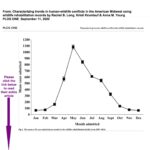 What Will Be My Busiest Months?
What Will Be My Busiest Months?
By the time injured or orphan animals reach you, some will already have health issues. For others their new settings and proximity to other animals might reduce their resistance to infection. You can’t duplicate conditions in the wild or the natural fears of animals. So all are going to be stressed to one degree or another. That could be the stress of fear, the stress caused by overheating, dehydration or the stress of having gone too long without a meal. So wildlife rehabilitators need to pay greater attention to hygiene and sanitation than what might be required on an ordinary farm or dairy. Here are some of the ways I try to minimizing those risks:
Sunshine
No germ or parasite like sunshine. You have probably read that it is the UV rays in sunshine that kill virus, fungi and bacteria. That is true. But even the normal sunshine rays (visible wavelengths) we see kill germs and parasites. How long that takes depends on a lot of things: how much grime surrounds and protects the organisms, the amount of moisture in the air and on the surfaces being disinfected, how porous the surfaces you are cleaning are, and how protected the organisms are by tough coatings or shells. For example, roundworm parasites and parvovirus are notoriously difficult to kill. In the case of roundworms, they are wrapped in an almost impenetrable shell. The most dangerous of all and one of the hardest to destroy is the roundworm of raccoons. In the case of parvovirus, they lack the outer fatty (phospholipid) coating that antiseptics like bleach and alcohol dissolve and that sunshine destroys.
On a sunny day in North America, nearly half of all UV radiation in sunshine is received between 10 AM and 4 PM. Sunlight exists in many wavelengths – some of them you can see and some you cannot. The most lethal wavelengths for parasites, bacteria and virus are those UV rays between 100 and 280 nanometers (typical viruses are 20–200 nm wide, a strand of your hair is about 80,000 nm wide). However only about 10% of the sunlight that reaches the earth is UV light and of that, only a third or so actually reaches the ground. That portion helps you make your vitamin D. When you receive too much of it, it is what causes your sunburn.
The nucleic acids that form a virus or bacteria’s DNA are about 260 nm across – just about the right size to be destroyed by a direct hit from a UV ray of sunshine. But those rays have the ability to cripple other components of disease organisms as well. (read here)
The non-UV portion of sunlight helps destroy infective organisms in other ways. The added heat and drying produced by non-UV sunlight reduces the number of bacteria present. Visible, non-UV sunlight also destroys light-sensitive components within bacteria. (read here) The drying that ordinary sunshine produces is also quite effect in killing most species of coccidia (read here) and the thin-walled, more fragile eggs and cysts of parasites like hookworms and giardia.
Household Cleaners
Bleach
The active ingredient in Clorox™ and generic bleach is sodium hypochlorite. Clorox™ is about 7.4% sodium hypochlorite when it leaves the factory. However the Company gives a hypochlorite range on its website because hypochlorite levels decline during storage. Generic brands can list as low as 5-6 percent sodium hypochlorite on the bottle. Although a few bacteria ( eg TB and pseudomonas) and fungi like aspergillus are known to be chlorine resistant at 200 ppm, most are not. So correctly-applied bleach is your least toxic and most effective way to keep bacterial, virus and parasite levels in check in your wildlife rehabilitation facility. Even chlorine-resistant organisms can be destroyed if the concentration and contact time with bleach is increased (for safety I never exceed 1 tablespoon of bleach per 1 quart of water). Bleach kills by oxidizing whatever organic material it comes in contact with (fire and rust are two other form of oxidation). In the process of oxidizing, the sanitizing and disinfecting ability of bleach is used up.
I go through gallons and gallons of bleach maintaing the sanitation of my rehab center. There are rumors that various Dollar Store outlets that sell bleach at discount prices stock older lots of bleach that have already lost some of their effectiveness. I do not know if that is true, but I try to purchase bleach at national outlets with fast turnover – Such as Wal-Mart.
Most experts suggest that off-the-shelf household bleach be diluted with tap water to give you a 200 parts per million final solution of hypochlorite. For Clorox™, that would be about 1 tablespoon of bleach per 1 gallon of water. How long your diluted bleach solution needs to be in contact with items and surfaces depends primarily on how much organic grime coats those objects and how porous they are. That is why I thoroughly brush-clean with soapy water and a hose or power wash before I apply the bleach solution. Most studies have found that clean, non-porous items and surfaces should be disinfected with 5 minutes. Movable items are then best placed in the sun where they will dry thoroughly. All bleach products are unstable. That is why Clorox™ gives a large spread in how much hypochlorite the bottle you bought might actually contain. The best strategy is to only purchase a few weeks supply at a time and to purchase it from a supermarket that has high product turnover.
It is unhealthy for your lungs to breath chlorine fumes. If you have a cleaning area outside, do your clean on a breezy day or in front of a fan. If you are cleaning with bleach indoors, do so with plenty of ventilation. Remove the animals and houseplants, set the AC/HVAC fan to ALWAYS ON. Never mix acidic substances (such as vinegar) or ammonia with bleach-containing solutions. Once diluted, bleach does not store well. Dilute bleach just before you intend to use it. If your eyes or nose are watering or stinging, if you are coughing, if you are having trouble breathing, if your skin itches or burns, if you are having to hold your breath or if you just don’t feel OK, you are doing something wrong and need to stop.
Pine-Sol®
Pine-Sol Cleaner & Disinfectant has been around since 1929. Its original formula included a substantial amount of pine tree sap which is rich in terpineol , a disinfectant. In 1990, the Pine-Sol brand was acquired by Clorox. In 2013 Clorox removed pine oil from the Pine-Sol formula because not enough pine oil was available anymore. They substituted glycolic acid instead. Because of consumer complaints, some of their pine-sol products sold in 2021 (Original Pine-Sol™) contain 8.75% pine oil again. I believe that their other formulas contain none or, when they do, they rely on pine-like compounds that are artificially produced. Natural pine tree oil is a very complex mixture of essential oils, many of which kill bacteria. One study found that the virus destroying ability of pine oil was about equal to that of a similar concentration of bleach hypochlorite. (read here) I love the freshly mopped odor Pine-Sol. But I confine its use to cleaning up smelly messes at the animal hospitals I have owned.
Dish Soap
I purchase a lot of the Ajax™ liquid dish soap that you see in the image above. Ajax is not actually a liquid soap, it is a detergent. Detergents are surfactants that emulsify any grease or oils that they come in contact with. In doing so, most of the grime and bacteria get washed down your sink’s drain. Ajax makes no claim that their product kills bacteria, virus or fungi. However, two of it’s ingredients, benzisothiazolinone and methylisothiazolinone are disinfectants. And even the surfactant detergent portion of your dish soap has properties that kill bacteria and virus. They do so by disrupting the fatty molecules that comprise the pathogen’s outer coating (their phospholipid membrane). (read here) But the main benefit of whichever detergent you choose to purchase is that it is going to removes the surface grime and coatings that interfere with the effectiveness of bleach, sunlight or drying.
Hands
I transfer Ajax liquid to a pump dispenser and wash my hands with it between caring for each animal. I follow that with a quick rinse of 70% isopropyl alcohol and then pat my hands dry with a paper towel. Be sure to scrub well under your fingernails. Bar hand soaps actually spread bacteria. There appears to be no benefit in washing your hands beyond the first two minutes. (read here) A palate of the considerably more expensive Ecolab™ pump action Foaming Hand Sanitizer you see in the photo was donated to us. It kills bacteria and virus equally as well because it contains 62% ethyl alcohol in addition to detergent. More about alcohol below.
Chlorhexidine
Chlorhexidine is an antiseptic that kills bacteria, virus, yeast and other fungi. It’s usually sold as a 4% hand washing and surgical site preparation (like Hibiclens™). It is also sold by the gallon as a 2% veterinary solution used to sanitize dairies and also as a medicated skin wash for dogs and cats. Chlorhexidine’s germicidal activity is a bit weaker and slower than the 70% isopropyl alcohol you buy at your supermarket. When chlorhexidine is purchased by the gallon it is inexpensive. At one time I used chlorhexidine quit a bit to sanitize my animal hospital. Today I use it rarely. There are many reasons why: For one, any organic matter present in areas where you apply chlorhexidine greatly reduce its effectiveness. Also, some bacteria like pseudomonas are resistant to it. But the most important reason I avoid using chlorhexidine is that it has a reputation for causing skin and hand irritation in people who are exposed to it frequently. (read here)
Surface Wipes
One of the photos on this page shows a round container of PDI Sani-Cloth™ Wipes. A palate of them came courtesy of our local hospital as well. They make nice exam and food prep table wipes and do kill bacteria, virus and fungi because they contain ordinary bleach as their active ingredient.
Alcohol
Isopropyl and ethyl alcohol are quite effective in rapidly killing bacteria, virus and fungi. (read here) Methyl alcohol is toxic. All alcohols kill by altering (denaturing) the vital proteins that all infectious organisms contain. When the bottle you buy says “denatured alcohol” (DA), it means that it is ethyl alcohol (aka grain alcohol) to which some bad-tasting or bitter substance has been added to be sure that no one drinks it.
For alcohol to be antiseptic, you need to rinse or spray objects in a solution that is a minimum of 30% alcohol. The higher the percentage of alcohol (up to ~ 80%), the faster the organisms will be killed. Soaking in alcohol increases rusting. Don’t leave puddles of it on stainless steel surfaces (bleach also makes it much more likely that stainless steel will rust). Alcohol also hardens rubber and some plastics . Like most antiseptics, alcohol is also weak in its ability to kill spores and organisms with shells it cannot penetrate. Keep in mind that alcohol (fumes) are very flammable. Anything over 45% can generate those flammable fumes when sprayed on hot surfaces.
The Danger Of Inhaling Wildlife Dander & Dust
I want to tell you about something you ought to keep in mind. Over the years two friends of mine, both dedicated wildlife rehabilitators, developed lung issues that permanently compromised their health. This problem is most often caused by inhaling bird feather dander. In the past some called it pigeon-breeder’s lung. Read more about that here & here. Exposure to excessive bird-related dust and dander is a problems in the poultry industry as well. (read here) This dander exposure can be a particular problem for wildlife rehabilitators while their young birds are replacing their infant down with feathers. I have also seen these lung problems in clients who own multiple cockatiels and cockatoos because those hookbills produce large amounts of “powder down” as a feather lubricant. Adult herons, bitterns, tinamous, and bustards also produce powder down.
Dander-related respiratory problems are most likely to occur in people working in confined spaces that house animals and have poor air exchange with the out-of-doors. Typical commercial air exchange rates are 2-8 air changes per hour. You are better off with 10-14. That means purchasing a larger (and separate) HVAC system wherever large numbers of animals are housed.
Few of us have the resources to do that. So my attempt to lessen this potential danger to me and my volunteers is to frequently clean my entire rehabilitation facility with a powerful vacuum cleaner such as the one in the photo above that I recently purchased at Home Depot to replace my smaller Shop-Vac™. I see to it that every table, cage unit, refrigerator or apparatus that I own sits on rollers (wheels). All of that goes outside on a sunny day during room cleanings. When outside, what is safe to hosed down gets hosed down. What can’t gets blown off with a leaf blower and then gets wiped down with a damp cloth.
I keep the word out that I am always on the lookout for discarded vacuum cleaner hoses. I tape them together with Gorilla™ tape and place the actual vacuum cleaner outside and as far away from the building as possible. Then, with the exhaust port facing away, I run only the lengthened vacuum hose inside the building. Set up that way there is no need for the filter. You cannot trust the filters of Shop-vacs and other consumer vacuums to trap dangerous fine dust particles anyway. If I had the resources now that I had when I managed the germ free animal and rodent colonies of the National Institutes Of Health, I would purchase a very long, lightweight, commercial vacuum hose. All our buildings had central vacuum lines:
Dealing With Unwanted Guests
Rodent Control
Rats find all facilities that house wildlife and livestock attractive places to live. You will never entirely eliminate them. But there are things you can do to minimize their numbers. The most important thing to do is to keep all your edibles in sealable varmint-proof metal containers. Seal your dumpsters as well. The second is to minimize their available food by using spill-reducing food containers and not overfilling them. The third is to attempt to block and seal all entrances to your facilities. Rats are unbelievably clever at finding small entry points. However they quickly abandon locations where food is not easily available to them (our common Norway rats rarely venture more than 150 feet from where they have dug their burrows).
You can attempt to live trap rats or put out snap traps but you will never catch the more cleaver ones. Rat baits will eliminate more of them. But dying rats spread disease and parasites around your facilities and carcasses can be easily eaten by recovering wildlife. Rats also tend to die in inconvenient, hard to get to, locations. You are much better off attempting to deny them food.
Wild rats carry a number of diseases that are a threat to the wildlife you are caring for and to you too. Many carry salmonella. Others carry leptospirosis. Although rats are also common carriers of toxoplasmosis , it is only when an infected rat is eaten that the parasite moves on to a new host.
Fire Ants
I live in South Texas where aggressive imported fire ants are common. They are a constant threat to the animals I care for in my outdoor cages and flights and for youngsters in the wild as well. Fire ant mounds are inconspicuous during dry periods. Shortly after rains is the best time to locate their mounds. The photo above is of the less expensive brand of fire ant poison I buy at WalMart, a generic product similar to Amdro™ which contains as its active ingredient hydramethylnon. The active ingredient in the one pictured is bifenthrin . Besides hunting for fire ant mounds after a rain, I coat all of the four 4″x 4″ treated lumber posts that suspend my bird flights with a 4″ painted ring of general purpose automotive grease mixed with permethrin. There is more information about permethrin use below. All of the insecticide compounds whose name ends in -thrin are very toxic to fish and may be to domestic and wild felines as well if consumed. Recently, none of the granular fire ant baits I used have been effective. I read that rain and high humidity cause these products to rapidly lose their effectiveness. I am now using a granular product called Over-N-Out™. Its active ingredients are cypermethrin along with bifinethrin and it has a reputation of lasting long in moist environments.
Cockroaches And Other Insect Pests
Organic mater and food scraps will bring cockroaches as well. I rely on Fipronil -containing products to control them. Fipronil is one of the active ingredient found in Frontline® topical flea & tick control products for dogs and cats. Never apply it unintentionally where it can come into direct contact with wildlife or their food. I generally apply a dab of the gel behind cabinet drawers and on the underside of sinks. But never on or near food preparation or storage.
Spinosad an approved “organic” product
This is an “off-label” use of spinosad. That means that it is not a government or manufacturer-approved use. Very few – if any – products are government-approved to treat wildlife. There is just not enough money to be made to justify the expense in doing so. So I make my decisions based on my experience caring for wildlife over the years. You will have to make your own decisions when you consider using any product off-label. I have no authority to suggest that you use unapproved products. I just tell you what I do and my experiences doing it.
Spinosad is sold under various manufacturer names. It is best known to dog and cat owners as the active ingredient in Elanco’s Comfortis® oral chewable tablets sold for the control of fleas on dogs and cats and Triflexis® in which the same company combines spinosad with milbemycin so that it will also kill heartworms.
The Naturalyte® Conserve Spinosad 0.5% that I pictured above is not approved for use on animals. Naturalyte® is marketed as one of the very few insecticides that the USDA approved for used by organic farmers. Spinosad is considered “organic” because it is naturally produced by a certain non-pathogenic bacteria. Spinosad is very effective in killing mites on poultry. (read here) Here in tropical south Texas, I mist spinosad on my Labrador retriever, Maxx, as an extra precaution against the kissing bugs and fleas that are so common here. But spinosad has also been effective for me in ridding starling chicks of mites and pelicans of feather-chewing lice. I first tested it on English sparrows. I add 0.5 ml of Naturalyte to 30 ml of water. Then I add a drop of Dawn™ dish soap before applying it as a light mist, using a 4 oz barbershop/hair salon spray bottle. Thirty milliliters is barely enough to activate a 4 oz mister; but enough to mist a great number of birds, bird boxes and the like. After misting, I gently blow dry the chicks when necessary. No nestling or adult birds have ever shown side effects and no mites have ever been seen on my treated animals again. If you decide to apply it, follow all precautions suggested on the label.
This is another “off-label” permethrin use. That means that it is not a government or manufacturer-approved use. Very few – if any – products are government-approved to treat wildlife. There is just not enough money to be made to justify the expense in doing so. So I make my decisions based on my experience caring for wildlife over the years. But you have to make your own knowledge-based decisions when you consider using any product off-label. I have no authority to suggest that you use unapproved products. I just tell you what I do and my experiences doing it.
Permectrin II® is a Boehringer Ingelheim permethrin product designed to rid livestock of flies, ticks and other pests. Permethrin is an artificial, enhanced and longer-lasting version of pyrethrin. Pyrethrin is an extract of the Dalmatian chrysanthemum that the plant produces to ward off insect predators. Although pyrethrin – when used alone – is considered “organic”, permethrin, being a synthetic product, is not. Permethrin is the active ingredient in the Nix® head louse and some scabies medications sold for humans. Permethrin is also the active ingredient in tick and mosquito repellent clothing. It is one of the active ingredients in Bayer’s K9 Advantix® II topical product to control ticks and fleas on dogs (never on cats).
As I mentioned above when I discussed fire ants, I mix Permectrin II® with a general purpose automotive grease and brush the mixture onto the 4 x 4 treated posts that support some of my outdoor flights. That is because ants, including fire ants and what appear to be extra-large carpenter ants, quickly learn to scale the posts to feed. They will kill small birds and mammals when allowed to do so. This concoction is the only one I have found that keeps them away for about a year. Tanglefoot™ is effective for about 4 months. Once enough dead ants and derbies have formed a bridge over the grease, it is time to scrape it off and apply a new coat. I also spray Permectrin II into all cracks and crevices that I suspect might harbor kissing bugs. Although permethrin has a very low toxicity to birds and most mammals, it is highly toxic to felines, fish and honey bees. Properly diluted, it is effective in killing mites and lice on birds. But allowing the spray or mist to get into or near their eyes needs to be avoided. I mix 0.2 ml Permectrin II® with 30 ml of water and then add a drop of Dawn™ dish-washing liquid. This mixture also has caused no side effects in the sparrows, starlings and pelicans I have used it on. I blow dry immature birds and mammals and be sure it is not applied in locations near where felines (cats), fish or honey bees reside. I follow all the precautions listed on the label.

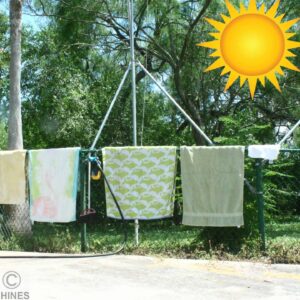

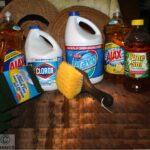
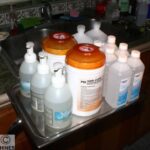
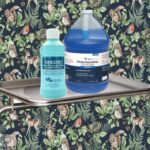
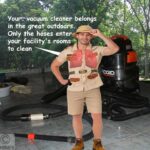
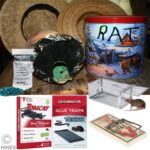
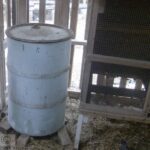
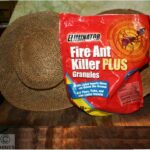
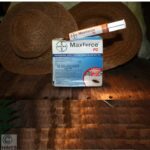
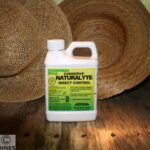
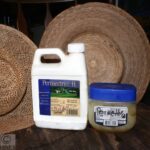
 Dear reader, Besides your donations, Visiting the products that you see displayed on this webpage also helps me pay the costs of keeping these articles on the Web. Best wishes, Ron Hines
Dear reader, Besides your donations, Visiting the products that you see displayed on this webpage also helps me pay the costs of keeping these articles on the Web. Best wishes, Ron Hines